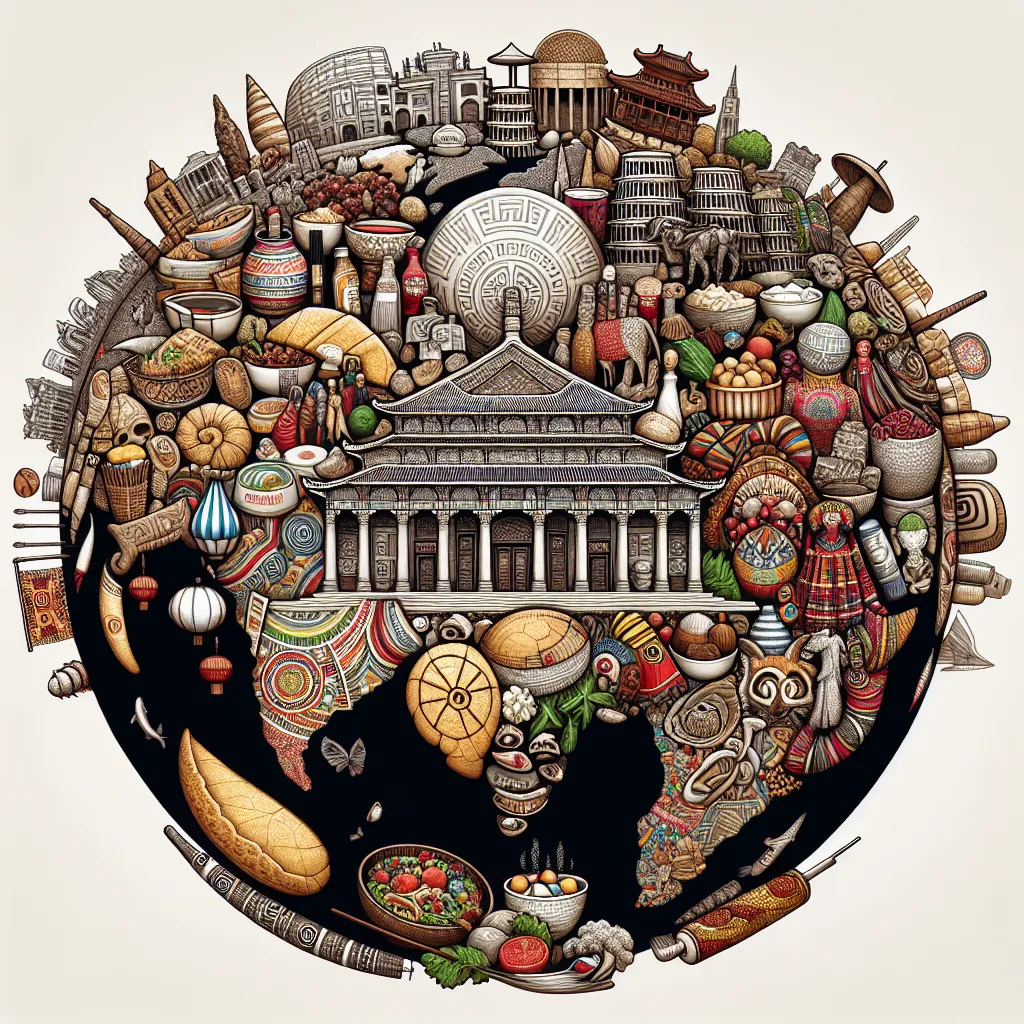The IELTS Reading section is a crucial component of the test, assessing your ability to comprehend complex texts and extract relevant information. Today, we’ll focus on a topic that has frequently appeared in IELTS exams: “Effects of globalization on cultural diversity.” This subject is not only relevant to the test but also reflects current global trends, making it a likely candidate for future IELTS Reading passages.
Based on historical data and current affairs, the theme of globalization and its impact on cultural diversity has been a recurring topic in IELTS exams. Its relevance in today’s interconnected world suggests a high probability of encountering similar passages in future tests. Let’s dive into a practice passage to hone your skills on this important subject.
Practice Reading Passage: Globalization and Cultural Diversity
The Text
Globalization, the process of increased interconnectedness and interdependence of world cultures and economies, has been a double-edged sword for cultural diversity. On one hand, it has facilitated the exchange of ideas, traditions, and customs across borders, enriching societies with new perspectives and experiences. On the other hand, critics argue that globalization has led to cultural homogenization, potentially eroding the unique characteristics of local cultures.
One of the most visible effects of globalization on cultural diversity is the spread of popular culture. Hollywood movies, American music, and Western fashion have permeated societies worldwide, sometimes at the expense of local artistic expressions. This cultural imperialism, as some scholars term it, has raised concerns about the loss of indigenous traditions and languages. For instance, many minority languages are at risk of extinction as younger generations adopt more widely spoken languages for economic and social advancement.
However, globalization has also provided platforms for preserving and promoting cultural diversity. The internet and social media have allowed small cultural groups to connect with wider audiences, sharing their traditions and art forms on a global stage. This digital preservation of culture has become crucial in maintaining cultural heritage in the face of rapid societal changes.
The tourism industry, boosted by increased global mobility, has had a complex impact on cultural diversity. While it has created economic incentives for communities to maintain their cultural practices and artifacts, it has also led to the commodification of culture in some cases. Traditional rituals and customs are sometimes altered to cater to tourist expectations, potentially diluting their authenticity.
In the realm of cuisine, globalization has led to both homogenization and diversification. Fast food chains have spread globally, often adapting their menus to local tastes. Simultaneously, the increased availability of international ingredients has allowed for a fusion of culinary traditions, creating new and diverse food cultures.
The business world has also been transformed by globalization, with multinational corporations operating across diverse cultural contexts. This has necessitated the development of cross-cultural communication skills and cultural intelligence among workers. While this has led to some standardization of business practices, it has also fostered an appreciation for diverse management styles and work cultures.
Education systems worldwide have been influenced by globalization, with an increasing emphasis on international curriculums and study abroad programs. This has broadened students’ cultural perspectives but has also raised concerns about the potential loss of local educational traditions and knowledge systems.
In conclusion, the effects of globalization on cultural diversity are multifaceted and often contradictory. While there are valid concerns about cultural homogenization, globalization has also created new avenues for cultural expression and exchange. The challenge lies in harnessing the positive aspects of global interconnectedness while preserving the rich tapestry of world cultures.
 Globalization and Cultural Diversity
Globalization and Cultural Diversity
Questions
1-5. Do the following statements agree with the information given in the reading passage?
Write:
TRUE if the statement agrees with the information
FALSE if the statement contradicts the information
NOT GIVEN if there is no information on this
- Globalization has only negative effects on cultural diversity.
- The spread of Western popular culture has raised concerns about the loss of indigenous traditions.
- Social media has played a role in preserving cultural diversity.
- Tourism always helps in maintaining the authenticity of local cultures.
- Globalization has led to the creation of new food cultures.
6-10. Complete the sentences below.
Choose NO MORE THAN TWO WORDS from the passage for each answer.
- Some scholars refer to the spread of Western culture as cultural ___.
- The ___ industry has had a complex impact on cultural diversity.
- In some cases, traditional customs are changed to meet ___ expectations.
- Multinational corporations have fostered an appreciation for diverse ___ styles.
- International curriculums and study abroad programs have broadened students’ ___ perspectives.
Answer Key
-
FALSE – The passage states that globalization has been a “double-edged sword,” implying both positive and negative effects.
-
TRUE – The passage mentions concerns about the loss of indigenous traditions due to the spread of Western popular culture.
-
TRUE – The text states that social media has allowed small cultural groups to share their traditions globally.
-
FALSE – The passage indicates that tourism can lead to the commodification of culture and alteration of traditions.
-
TRUE – The text mentions that the fusion of culinary traditions has created new and diverse food cultures.
-
imperialism
-
tourism
-
tourist
-
management
-
cultural
Explanation
- The passage describes both positive and negative effects of globalization on cultural diversity, not just negative ones.
- The text explicitly mentions concerns about the loss of indigenous traditions due to cultural imperialism.
- The passage states that social media has allowed small cultural groups to share their traditions globally, contributing to cultural preservation.
- The text indicates that tourism can lead to the commodification and alteration of cultural practices, contradicting the idea that it always helps maintain authenticity.
- The passage mentions the fusion of culinary traditions creating new food cultures as a result of globalization.
6-10. These answers are directly stated or strongly implied in the text. Pay attention to specific terminology and context clues in the passage.
Common Mistakes
- Overgeneralizing: Be cautious about statements that use absolute terms like “always” or “never.” The passage often presents nuanced views.
- Misinterpreting tone: The text aims to present a balanced view of globalization’s effects. Avoid assuming a solely positive or negative stance.
- Overlooking specific details: Questions often require precise information from the text. Skim-reading might lead to missing crucial details.
- Inferring beyond the text: Stick to the information provided. Avoid bringing in external knowledge or making assumptions not supported by the passage.
- Misunderstanding vocabulary in context: Words like “commodification” or “imperialism” have specific meanings in this context. Ensure you understand their usage.
Key Vocabulary
-
Globalization (noun) /ˌɡləʊbəlaɪˈzeɪʃən/ – The process of businesses or other organizations developing international influence or starting to operate on an international scale.
-
Cultural diversity (noun phrase) /ˈkʌltʃərəl daɪˈvɜːsəti/ – The existence of a variety of cultural or ethnic groups within a society.
-
Homogenization (noun) /həˌmɒdʒənaɪˈzeɪʃən/ – The process of making things uniform or similar.
-
Indigenous (adjective) /ɪnˈdɪdʒənəs/ – Originating or occurring naturally in a particular place; native.
-
Commodification (noun) /kəˌmɒdɪfɪˈkeɪʃən/ – The transformation of goods, services, ideas, or other entities that may not normally be regarded as goods into a commodity.
Grammar Focus
Pay attention to the use of complex sentence structures in the passage. For example:
“While it has created economic incentives for communities to maintain their cultural practices and artifacts, it has also led to the commodification of culture in some cases.”
This sentence uses a concessive clause (starting with “While”) to present contrasting ideas. Understanding such structures can help in comprehending the nuanced arguments presented in IELTS Reading passages.
Tips for IELTS Reading Success
-
Practice active reading: Engage with the text by underlining key points and making mental summaries as you read.
-
Improve your vocabulary: Regularly learn new words and phrases, especially those commonly used in academic and journalistic writing.
-
Time management: Allocate your time wisely. Spend more time on difficult questions, but don’t get stuck on any single question.
-
Skim and scan effectively: Use these techniques to quickly locate specific information in the text.
-
Read the questions carefully: Ensure you understand exactly what each question is asking before searching for the answer.
-
Don’t rely on prior knowledge: Base your answers solely on the information provided in the passage.
-
Practice regularly: Familiarize yourself with various question types and develop strategies for each.
-
Stay calm and focused: Remember, not all questions are designed to be equally difficult. If you’re struggling with one, move on and come back to it later if time allows.
By focusing on these strategies and continuously practicing with diverse texts, you can improve your performance in the IELTS Reading section. Remember, understanding complex topics like the effects of globalization on cultural diversity not only helps in the test but also enhances your overall English proficiency and global awareness.
For more insights on related topics, you might find these articles helpful:
- How Does Globalization Influence Language Use and Preservation?
- What Are the Challenges of Preserving Cultural Heritage in the Modern World?
- Cultural Impacts of Globalization on Arts and Culture
Keep practicing, and you’ll be well-prepared for your IELTS Reading test!


